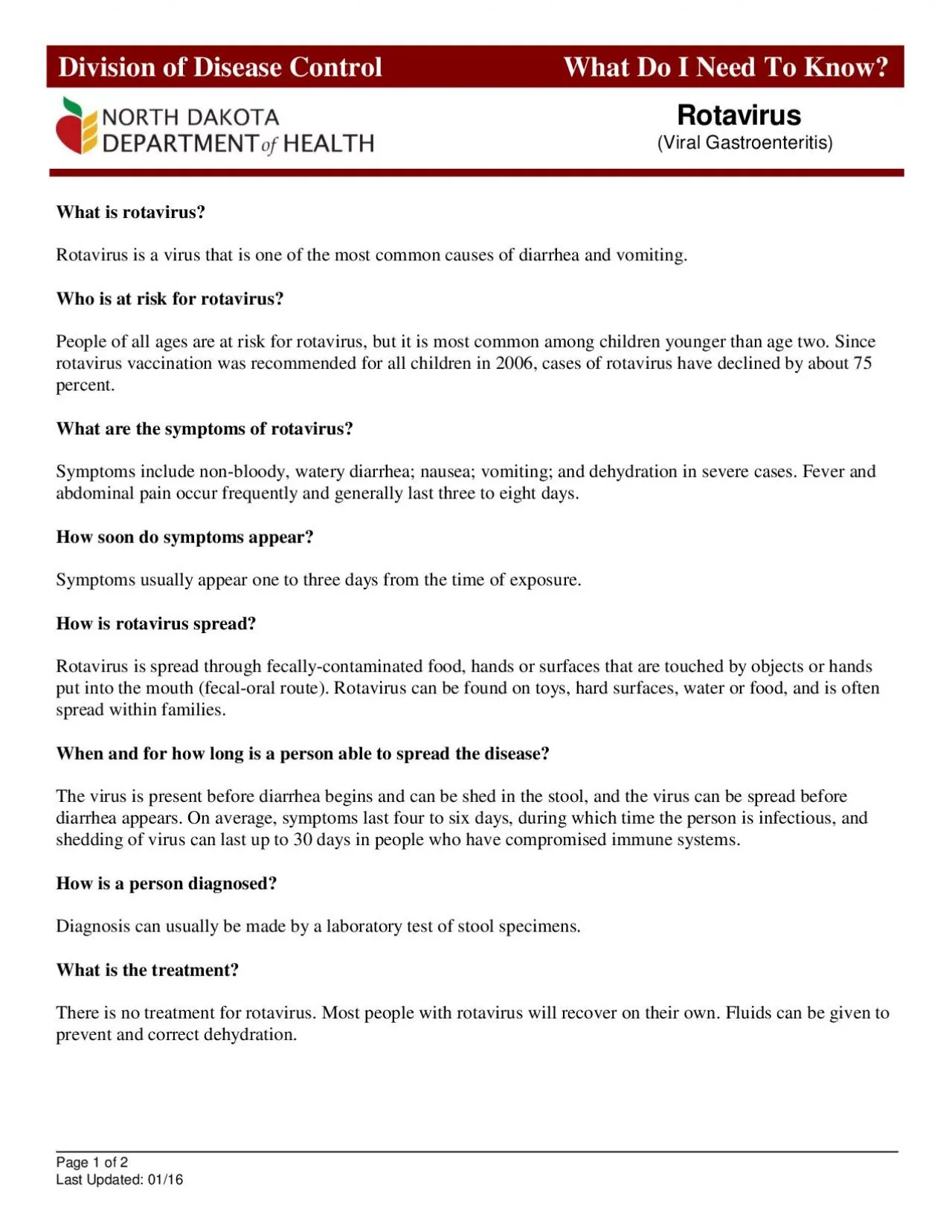

P age 1 of 2 L 0 116 Rotavirus Viral G astroenteritis What is r otavirus Rotavirus is a virus that is one of the most common caus es of diarrhea and vomiting Who is at risk for r otavir ID: 949990
Download Pdf The PPT/PDF document "ast Updated" is the property of its rightful owner. Permission is granted to download and print the materials on this web site for personal, non-commercial use only, and to display it on your personal computer provided you do not modify the materials and that you retain all copyright notices contained in the materials. By downloading content from our website, you accept the terms of this agreement.
P age 1 of 2 L ast Updated: 0 1/16 Rotavirus (Viral G astroenteritis) What is r otavirus ? Rotavirus is a virus that is one of the most common caus es of diarrhea and vomiting. Who is at risk for r otavirus ? People of all ages are at risk for rotavirus, but it is most common among child ren younger than age two . Since rotavirus vaccination was recommended for all children in 2006, cases of rota virus have declined by about 75 percent. What are the symptoms of r otavirus ? Symptoms include non - bl oody, watery diarrhea ; nausea ; vomiting ; and dehydration in severe cases . Fever and abdominal pain occur frequently and generally last three to eight day s. How soon do symptoms appear? Symptoms usually appear one to three days from the time of exposure . How is r otavirus spread? Rotavirus is spread through fecally - contaminated food, hands or surfaces that are touched by obje cts or hands put into the mouth (fecal - oral route) . Rotavirus can be found on toys, hard surfaces , water or food , and is often spread within families. When and for how long is a person able to spread the disease? The v irus is present before diarrhea be gins and can be shed in th e stool , and the virus can be spread before diarrhea appears . O n average , symptoms la st four to six days , during which time the person is infectious , and shedding of virus can last up to 30 days in people who have compromised immune systems . How is a pe rson diagnosed? Diagnosis can usually be made by a laboratory test of stool specimens. What is the treatment? There is no treatment for rotavirus. Most people with rotavirus will recover on their own. Fluids can be given to prevent and correct dehy dration. Division of Disease Control What D o I Need T o Know? P age 2 of 2
L ast Updated: 0 1/16 Does past infection make a person immune? No, a person can get infected more than once because the virus has many types. Should children or others be excluded from child care, school, work or other activities if they have r otavirus ? A chil d should be excluded from child care if he/she has : V omited two or more times within the previous 24 hours, unless the vomiting is determined to be caused by a non infectious condition and the child is not in danger of dehydration Diarrhea , if stool is not contained in the diaper or if diarrhea frequency exceeds two or more sto ols above normal for that child A fever or is unable to participate and the staff determines that they cannot care for the child without compromising their ability to care for the heal th and safety of the other children in the group A child or an adult should be excluded from school or work until diarrhea resolves. An adult who prepares or handles food should be excluded from work until 24 hours after diarrhea resolves. What can be do ne to prevent the spread of r otavirus disease? Children should receive two or three doses of r otavirus vaccine , depending on the brand of vaccine administered. The three dose schedule should be given at 2, 4 and 6 months of age. The two dose schedule sho uld be given at 2 and 4 months of age. The first dose should be given between 6 and 1 4 weeks of age. Children should have received all doses by eight months of age . C hildren eight months of age and younger who attend early childhood facilities in North Da kota are required to be immunized against rotavirus. Hand washing is the mos t important prevention method. This should be done particularly after toileting or diapering and before any contact with food or surfaces involved in preparation and serving food. Thoroughly clean and disinfect contaminated surfaces immediately after an episode of illness by using a bleach - based household cleaner , or one with 70% ethanol alcohol concentration . Additional I nformation : Additional information is available at www.ndhealth.gov/disease or by calling the North Dakota Department of Health at 800.472.2180. Resources: American Academy of Pediatrics. [Rotav irus.] In: Kimberlin DW, Brady MT, Jackson MA, Long SS, eds. Red Bo ok: 2015 Report of the Committee on Infectious Diseases. 30 th ed. Elk Grove Village, IL: American Academy of Pediatrics; 2015: 684 - 688 .